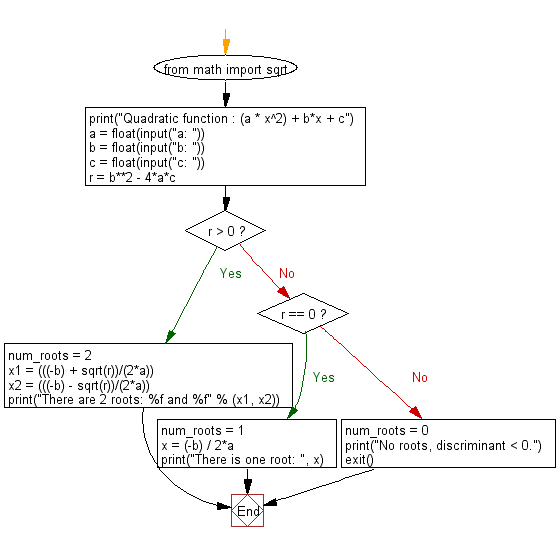Python Math: Find the roots of a quadratic function
Python Math: Exercise-30 with Solution
Write a Python program to find the roots of a quadratic function.
Sample Solution:-
Python Code:
from math import sqrt
print("Quadratic function : (a * x^2) + b*x + c")
a = float(input("a: "))
b = float(input("b: "))
c = float(input("c: "))
r = b**2 - 4*a*c
if r > 0:
num_roots = 2
x1 = (((-b) + sqrt(r))/(2*a))
x2 = (((-b) - sqrt(r))/(2*a))
print("There are 2 roots: %f and %f" % (x1, x2))
elif r == 0:
num_roots = 1
x = (-b) / 2*a
print("There is one root: ", x)
else:
num_roots = 0
print("No roots, discriminant < 0.")
exit()
Sample Output:
Quadratic function : (a * x^2) + b*x + c a: 5 b: 20 c: 10 There are 2 roots: -0.585786 and -3.414214
Flowchart:

Visualize Python code execution:
The following tool visualize what the computer is doing step-by-step as it executes the said program:
Python Code Editor:
Have another way to solve this solution? Contribute your code (and comments) through Disqus.
Previous: Write a Python program to calculate wind chill index.
Next: Write a Python program to convert a binary number to decimal number.
What is the difficulty level of this exercise?
Test your Programming skills with w3resource's quiz.
Python: Tips of the Day
Find current directory and file's directory:
To get the full path to the directory a Python file is contained in, write this in that file:
import os dir_path = os.path.dirname(os.path.realpath(__file__))
(Note that the incantation above won't work if you've already used os.chdir() to change your current working directory, since the value of the __file__ constant is relative to the current working directory and is not changed by an os.chdir() call.)
To get the current working directory use
import os cwd = os.getcwd()
Documentation references for the modules, constants and functions used above:
- The os and os.path modules.
- The __file__ constant
- os.path.realpath(path) (returns "the canonical path of the specified filename, eliminating any symbolic links encountered in the path")
- os.path.dirname(path) (returns "the directory name of pathname path")
- os.getcwd() (returns "a string representing the current working directory")
- os.chdir(path) ("change the current working directory to path")
Ref: https://bit.ly/3fy0R6m
- New Content published on w3resource:
- HTML-CSS Practical: Exercises, Practice, Solution
- Java Regular Expression: Exercises, Practice, Solution
- Scala Programming Exercises, Practice, Solution
- Python Itertools exercises
- Python Numpy exercises
- Python GeoPy Package exercises
- Python Pandas exercises
- Python nltk exercises
- Python BeautifulSoup exercises
- Form Template
- Composer - PHP Package Manager
- PHPUnit - PHP Testing
- Laravel - PHP Framework
- Angular - JavaScript Framework
- Vue - JavaScript Framework
- Jest - JavaScript Testing Framework
